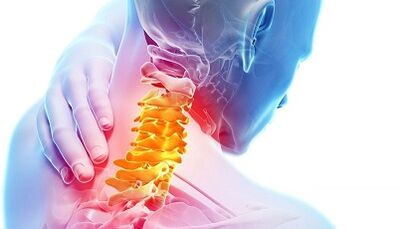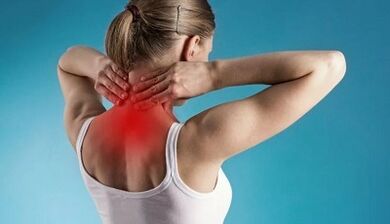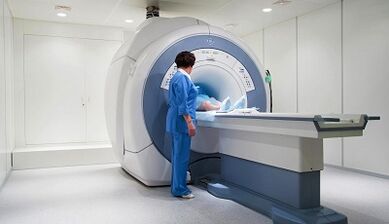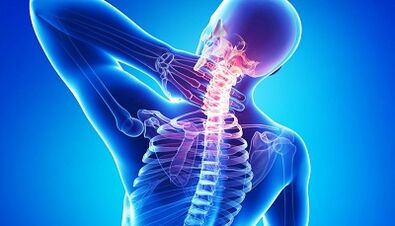Among all violations of the musculoskeletal system, second place in terms of prevalence is occupied by cervical spinal osteochondrosis.Symptoms and treatment of the disease are determined by its stage of development, so it is important not to release the signs of the disease.
Cause and symptoms of cervical spinal osteochondrosis

Osteochondrosis is called dystrophic change in cartilage with the background of the intervertebral disc wound.
Cervical osteochondrosis is characterized by the destruction of the pathology of the vertebral cartilage that supports the head.
Often, the disease is diagnosed in people aged 30 to 40.In developed countries, this or another level of cervical osteochondrosis is diagnosed in 80% of the population.
The neck is considered the most portable spine.At the same time, there is an insufficient amount of muscle in the neck that can balance the load on the spine.Therefore, most loads fall on the intervertebral disc which plays the role of shock absorption.
As a result, the disc wear, dry and leveling, osteochondrosis develops.
The reasons that contribute to the emergence of pathology are not only in anatomy, but also in human behavior:
- Soweity and static, inactive work - on computers, car driving, in the office;
- Overweight;
- Great physical hard work;
- smoking;
- Incorrect nutrition;
- poor physical form;
- Spinal injury.
Additional provocative factors in the development of osteochondrosis are: flat feet, soft mattresses and pillows, habits of wearing bags, hypothermia and pressure.
How is the disease real
At the beginning of the disease about its development, only the neck flow, which usually does not pay attention.With pathological progress, the number and intensity of the manifestation increased.
Symptoms of cervical osteochondrosis characteristics occur:
- pain in the back of the head, at the base of the neck, giving it to the limbs;
- Crunch and pain when turning on the head;
- numbness or tingling of the area between the shoulder blade and the base of the neck, burning, discomfort and stiffness;
- headache, migraine, dizziness;
- Disadvantages, fatigue.
Secondary symptoms are considered a decline in vision, hearing, memory problems, sleep disorders, uncertainty, disorders, stress.
Syndrome caused by cervical spinal osteochondrosis

Doctors classify the signs of osteochondrial processes as a syndrome related to certain types of spine.
Stenosis.It develops with the background of the intervertebral disc hernia and is accompanied by a violation of blood circulation and bone tissue growth.It is indicated by the numbness of the limbs.
Reflexes and unpredictable syndrome- Due to compression of the vertebral artery with neck curvature and affected posture.It shows itself in severe paroxysmal pain in the occipital area with a gradual spread to the area around the forehead.
Rook Syndrome.It is observed when leveling the root of the spinal cord - as a result of the hernia.At the same time, sensitivity in the affected area is reduced, and motor activity is limited.It may be accompanied by the development of speech defects, snoring, impaired odor, decreased muscle sensitivity -the tongue.
Stage of development of cervical osteochondrosis
The complexity of the process is determined by the state of the pulpoos nucleus that fills the vertebral space.
Degenerative wounds in the cervical region are divided into three stages:
- First.The intervertebral disc is compacted.The vertebral hook is increasing.Muscle stiffness appears, but their mobility has not changed.Small edema and pain when turning on the head is possible;
- The second.It develops with the background of the first stage progress of the disease, if the treatment of cervical spinal osteochondrosis is not present or performed incorrectly.The intervertebral holes are narrow, the height of the intervertebral disc becomes less due to leveling.Pinches nerve root.The patient feels painful pain;
- The third.The fractures in the fibrous ring surrounding the intervertebral disc causes capsule rupture and muscle tissue deformation.The stability of the pulpos nucleus in the intervertebral disc is violated.Intervertebral hernia develops.It is characterized by acute pain in the neck, tongue numbness, edema, mobility limitations, spinal curvature.
The correct position of the cervical region vertebra determines the function of the visual and hearing nerve, the nose, lips, mouth, throat, teeth, facial nerves, pituitary, brain, parasympathetic nervous system, neck and lower arm muscles, thand glands, elbows and shoulders.
Diagnostic method

The exact determination of the development of osteochondrosis allows you to intentionally affect the disease.Initial diagnosis is shown after an initial examination by the doctor.
Patient complaints about the nature of the pain syndrome are taken into account, as well as the information obtained during spinal examination in various positions.Cervical parcel studies allow you to determine the presence of seals and deformation.In addition, attention is given to muscle tone and motor capacity of the patient.
Doctors receive complete diagnostic information using studies such as:
- Radiography.This procedure allows you to evaluate the state of the vertebra in two projections - straight and lateral.The result is the determination of damage, salt deposits and compacted formations;
- Magnetic resonance tomographyAllows you to establish not only spinal pathology, but also a level of severity.By means of MRI, a doctor can assess the condition and degree of damage to the nerve endings, blood vessels and intervertebral discs;
- Computed tomography- digitalization of information obtained by X -Ray irradiation.
In the presence of dizziness, additional studies on structural changes in blood vessels through domorography, angiography and duplex scanning may be needed.
How to treat cervical osteochondrosis?
After making the right diagnosis and explaining the cause of the disease development, neurologists determine how to treat cervical osteochondrosis.
Optimal results are carried by complex therapy, which provides the use of several methods.Protocols include drug effects, hardware procedures, exercise therapy and therapeutic massage.
Treatment with medications

In each individual case, the choice of drugs occurs individually.It depends not only on pathological severity, but also on the specific features of the patient's body.
Permanent drug treatment remedies:
- anti -inflammation - tablets that relieve pain and inflammation;
- Chondroprotectors - a drug that activates the regeneration of cartilage tissue;
- External use - ointment and gel that stops pain and inflammation;
- Vitamin complex to support the body and stimulate its recovery.
In the first stage of therapeutic effects, it is possible to improve the pain syndrome - this is the reaction of the muscle system.To reduce discomfort and improve drug treatment, physiotherapy procedures are used.
Physiotherapy
Physiotherapy means the effect of the cause of the disease using special equipment - electrophoresis, electrical stimulation of tissue.The use of low frequency current improves blood circulation in affected areas, relieves edema and pain, and at the same time increases the effectiveness of medical effects.
The minimum course of hardware treatment is 10 sessions.
Massage for cervical osteochondrosis at home
Manual therapy is a productive way to affect the affected area at home.With the help of massage, pinching, muscle cramps and pain eliminated, blood circulation improved, and nerve root compression was reduced.
Thanks to the massage, the metabolism improved, and the spinal tissue was restored.
Media Physical Education for cervical spinal osteochondrosis
The best method for restoring the function of the organ -the musculoskeletal system and the prevention of relapse is Physiotherapy Physiotherapy Education for cervical area osteochondrosis.This procedure is prescribed after completely relieving pain and inflammation.
The main type of exercise therapy:
- medical gymnastics;
- walking;
- class on simulator;
- swim.
In order for training for cervical osteochondrosis to bring the expected results, the class must be held under the supervision of competent experts.
The recovery of the people
Complete removal of cervical osteochondrosis using traditional medical methods is impossible.On the other hand, the use of folk remedies allows you to improve the patient's condition, relieve inflammation, reduce pain and strengthen immunity.
Flat -Rata, therapeutic period with cervical osteochondrosis takes up to three months.If conservative treatment does not produce the expected results, surgery is used.
Why is cervical osteochondrosis dangerous?

Pathology in the neck pose a serious threat to all human health.Because the neck connects the head to the body, in this part of the spine there are all important biological communications - the arteries that feed the brain, the nerve tract.
Any changes in the function of the cervical region require the consequences of:
- Disorders of blood circulation and brain nutrition.As a result, hypertension, pathology of respiratory system and cardiovascular system, VSD, impaired coordination, hearing problems, vision and speech developed;
- Vertebrate artery syndrome.Pathology develops with the background of squeezing a vessel that feeds cerebellum and oval brain.The development of cervical osteochondrosis can cause ischemia and stroke;
- Radiculopathy - damage to nerve roots, bone tissue growth in the vertebra, resulting in loss of partial or complete mobility.
The most dangerous compression of the spinal cord, located in the spine.Such pathology leads to rupture of spinal cord shells and causes paralysis.In very severe cases, cervical osteochondrosis ends dead.
Prevention
Even after a complete recovery, the disease can return if the patient does not review his lifestyle - work and rest, habits, food.
As a precautionary measure, neurologists recommend paying attention to the following:
- The rigidity of the mattress.The ideal option is low orthopedic mattresses and pillows;
- Visits to the sauna are required for relaxation and removal of complete muscle cramps;
- Daily hot baths are a great tool for improving blood circulation;
- Swimming, walking, stimulating blood circulation, strengthening the spinal muscles;
- Proper nutrition is a rejection of products that slow down metabolism: fatty, fried, sweet, smoke, flour and alcohol.Meals with gelatin, dairy products, nuts, vegetables, white meat, seafood are recommended.

In everyday life, large physical efforts should be avoided, a sharp head, prolonged sitting or in a static position.In addition, it is advisable to use chairs that support the head and back.
Active living, healthy foods and morning exercises are an easy but effective way to prevent most diseases and live a long life without pain and discomfort.


















